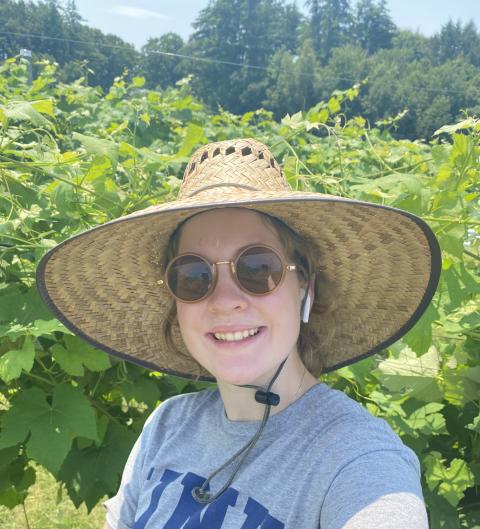
Ella Lukacz is a sustainable agriculture and food systems major and history minor from Portsmouth, New Hampshire.
COLSA: Tell us about your research in as non-technical language as possible.
Ella Lukacz: For the last two summers, Becky Sideman and I have been collecting data on 16 varieties of hydrangeas from three species: H. paniculata, H. arborescens, and H. quercifolia. These three species are cold hardy through USDA planting zone 4-5 and were evaluated for landscape and cut flower use at Woodman Farm from 2020-2023. A preliminary survey by Sideman and her former research assistant for NH flower growers and florists showed great interest in buying and producing locally grown hydrangeas.
Our research aims to address three objectives. To evaluate the establishment success and cold hardiness of the hydrangea cultivars in New Hampshire by measuring winter bud survival, first bud break, vigor in the following year, disease incidence, and other critical qualitative factors. To determine the suitability of the cultivars for use as cut flowers by measuring several characteristics important to growers and florists, including flowering time and flowering duration, stem length, head size, flower color, and shelf-life. And raise awareness among commercial farmers and floral designers regarding the potential of perennial hydrangea shrubs as a perennial cut flower crop.
COLSA: What challenge/issue does your research seek to address?
Ella: The number of farms producing field-grown cut flowers in New Hampshire has increased by 60% in the ten years from 2007 to 2017. This statistic indicates that cut flowers are an important specialty crop for New Hampshire, and there is a strong demand for regionally grown flowers. Hydrangeas are perennial plants that, once established, are low maintenance and can offer farmers a harvestable product for many years. The “big leaf” hydrangea is the most commonly sourced hydrangea (H. macrophylla).
However, this species is only winter hardy through USDA planting zone 6, and when grown in Northern New England, winter injury and plant death are common. The H. paniculata and H. quercifolia hydrangeas are cold tolerant, and their attractive characteristics make them promising species for cut flower production in NH. New varieties are constantly being offered for landscape use.
Still, little or no information on cultivar performance is available to guide growers in selecting those that will perform best for cut flower production. No studies have evaluated cultivars of these species in the Northeast and beyond, so providing information to the commercial farming community is almost impossible. Our research aims to address this problem by evaluating the cultivars growing at Woodman Farm for cut flower and landscape use.
COLSA: What has your experience conducting undergraduate research been like so far?
Ella: Since joining Becky Sideman’s lab two years ago, I have been given much freedom in what and how I want to conduct research. During the first summer with Becky, I designed a cut flower experiment measuring harvest stage, cold storability, vase life storability, and a stem recut technique. After conducting this research in 2022, I used what I found that summer to create a poster for the spring 2023 URC.
Seeing my research go from fieldwork to scientific poster was a great experience and came with many learning opportunities. This past summer, I conducted the cut flower experiment again while designing and implementing a pollinator survey on the H. paniculata species to see which varieties are most attractive to pollinators.
Conducting undergraduate research has been such an eye-opening experience. I have fallen in love with the research process of asking a question, designing an experiment, and seeing if the question is answered. Learning from Becky Sideman and everyone in her lab has given me so many skills that I will take with me in the future, be it agriculture research or not.
COLSA: Are there funding sources and/or collaborators we should acknowledge? If so, please list.
Ella: Kaitlyn Orde conceived of and initiated this project. We thank Cathy Neal, Extension Specialist Emeritus, for her guidance; and Evan Ford, Kyle Quigley, Mark Trabold, Marley Gonsalves, Caterina Roman for technical assistance. We also thank the Anna & Raymond C. Tuttle Environmental Horticulture Endowment, the NH Department of Agriculture, Markets & Food, and the NH Agricultural Experiment Station for financial support of this work.
COLSA: What do you love most about UNH?
Ella: I love many aspects of UNH, but I especially love how there are so many opportunities in and out of the classroom to experience hands-on learning. UNH is a research university, making getting involved in research accessible to undergraduates. I also love the university's involvement in NH agriculture and the excellent information the four research farms produce.